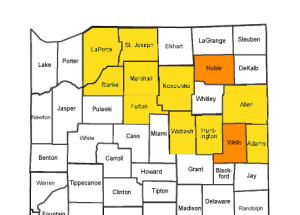It is a snowy weekend in northern Indiana.
The National Weather Service issued winter storm warnings and advisories on Saturday for about two dozen counties in the northern half of the state.

The advisories and warnings were for counties along Lake Michigan and the state’s northern border. They predicted up to 12 inches of snow starting later Saturday in some parts through early Monday morning. The South Bend area could receive 6 to 10 inches of snow. Other areas to the south could see two inches or more.

Weather officials are advising caution on the roads with reduced visibility.
The Indiana Department of Transportation on Saturday advised travelers facing snowy road conditions to reduce speeds and keep a safe distance between vehicles, especially around snow plows. Travel Advisories were issued for St. Joseph, LaPorte, Marshall, Starke and Kosiusko Counties in the 95.3 MNC listening area, meaning travel conditions are hazardous. Noble County was placed under a Travel Watch, meaning unnecessary travel is not recommended.

- Link to current road conditions
- Link to current travel advisories in Indiana
- Link to information on plow procedures
95.3 MNC continues to air extended weather updates every 15 minutes on air throughout the day on Sunday, with frequent updates during the Chicago Bears game. For weather alerts direct to your cell phone, text NEWS to 45364 or click here.
Church and community delays, postponements and cancellations and Monday’s school delays or closings can be found here.
LIVE on #Periscope: Snowy Sunday update https://t.co/oBGINMVf7Z
— Tom Coomes (@TomCoomes) December 11, 2016
2:00 AM: Snow is really coming down at our studios! @ABC57News pic.twitter.com/YQTMldH90r
— Julia Palazzo ABC 57 (@JuliaPalazzoTV) December 11, 2016
Safe driving tips and information offered by AAA Chicago Motor Club:
- Emergency Kit: AAA encourages motorists to update their emergency roadside kit for winter to include a mobile phone and car charger; blankets; a flashlight with extra batteries; a first-aid kit; drinking water; a small shovel; a sack of sand, cat litter or traction mats; windshield scraper and brush; battery booster cables; and emergency flares or reflectors.
- Antifreeze: Check antifreeze annually to ensure it will withstand the winter cold. A 50/50 mixture of coolant and water will protect against freezing.
- Windshield wipers and washer fluid: Replace wiper blades if they do not clear the glass in a single swipe without streaking. Where appropriate, consider the use of special winter blades that offer improved performance in snow and ice conditions. Fill the windshield washer reservoir with winter detergent fluid to prevent freeze up.
- Tires: Cold weather reduces tire inflation pressure, so check tire pressures frequently and maintain the vehicle manufacturer’s recommended pressure found on the driver’s door jamb—not the pressure stamped on the tire sidewall. Motorists should never reduce tire pressure in an attempt to increase traction on snow and ice. This does not work, and when the roads dry out it can cause excessive tire wear and vehicle handling problems.
- Battery: Check for a secure fit and clean away any corrosion on the battery and its cable connections. If the battery is out of warranty, it’s advisable to have it tested before cold weather hits. Faulty batteries cause more car starting problems than any other factor.
- Gas Lines: Keep the fuel tank at least half-full to avoid fuel-line freeze-up.
- Belts and hoses: Replace accessory drive belts that are cracked, glazed or frayed, as well as coolant hoses that are visibly worn, brittle, bulging or excessively soft. Check for leaks around hose clamps and at the radiator and water pump.
Additionally, AAA recommends the following tips for winter driving:
- When you see flashers, move over a lane if possible and slow down as you’re passing emergency vehicles. This law applies to any vehicle – including tow trucks – that displays flashing lights and is stationary on the side of the road.
- Before starting out in snowy weather, remove the snow from the entire car so it doesn’t blow onto your windshield or the windshields of other drivers. Make sure your mirrors, lights, brake lights and turn signals are clean.
- To increase your visibility, drive with your low-beam headlights illuminated at all times.
- All passengers should be safely secured with their safety belts fastened. Any items that may become dangerous flying projectiles during a crash should be stored in the trunk.
- Watch for icy surfaces on bridges and intersections, even when the rest of the road seems to be in good condition.
- Always reduce your speed and increase your following distance when poor road or weather conditions prevail.
- Look farther ahead in traffic. Actions by other drivers will alert you to problems and give you extra seconds to react.
- When changing lanes, avoid cutting in front of trucks, which need more time and distance than passenger vehicles to stop. Hard braking may cause a vehicle to skid.
- Never use cruise control if the roads are wet, slick or snow packed.
- Remember that four-wheel drive helps you to get going quicker, but it won’t help you stop any faster.
- If your vehicle is equipped with anti-lock brakes, apply constant, firm pressure to the pedal when stopping. You may feel or hear a thumping sound when the system is engaged.
The Associated Press contributed to this story.

